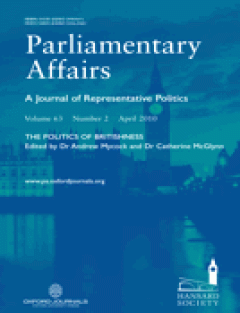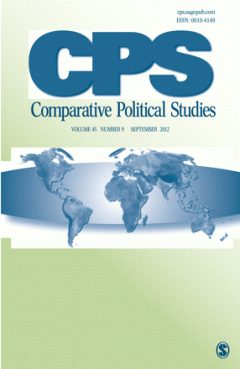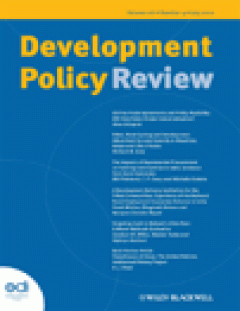Filter by

A Golden Interlude : Journalists in Early Twentieth Century British Literature
This article examines fictional representations of journalists and journalism from Guy Thorne's Edwardian bestseller When it Was Dark (1903) through to novels of the interwar years. It examines how literature about journalism and journalists addresses contemporary issues such as the march of technology; the relationship between politics and the press at a time when the franchise was extending; …
- Edition
- Volume 64, Issue 2, April 2011. Pp. 326-340
- ISBN/ISSN
- 00312290
- Collation
- -
- Series Title
- Parliamentary Affairs
- Call Number
- -

Reviewing Select Committee Tasks and Modes of Operation
Departmental select committees are now the principal mechanism through which the House of Commons holds the executive to account. Ten years ago the Hansard Society's Commission on Parliamentary Scrutiny (the Newton Commission) recommended a series of reforms to select committees including the introduction of core tasks. A decade on, however, many new demands have since been placed on committees…
- Edition
- Volume 64, Issue 2, April 2011. Pp. 354-369
- ISBN/ISSN
- 00312290
- Collation
- -
- Series Title
- Parliamentary Affairs
- Call Number
- -

Does It Take Democrats to Democratize? Lessons From Islamic and Secular Elite…
Do political-Islamic elites need to be democrats for participation in democracy, how do their values compare to secular elites�, and how do their values change through participation and affect democratization itself? A comparative-systematic content analysis of three Islamic-conservative and two pro-secular Turkish newspapers over nine years shows that, overall, political-Islamic elites adopt d…
- Edition
- Vol. 44 no. 5, May 2011.pp. 511-545
- ISBN/ISSN
- 00104140
- Collation
- -
- Series Title
- Comparative Political Studies
- Call Number
- -

Understanding the Multinational Game : Toward a Theory of Asymmetrical Federa…
This article presents a baseline theory of asymmetrical federalism in multinational states. Two arguments building on a game-theoretic foundation link central and regional elites� strategic choices to questions of federal stability. The first argument concerns the creation of asymmetrical institutions. In a confrontation game between the center and national minorities credibly threatening to ex…
- Edition
- Vol. 44 no. 5, May 2011.pp. 546-571
- ISBN/ISSN
- 00104140
- Collation
- -
- Series Title
- Comparative Political Studies
- Call Number
- -

Shadows From the Past : Party System Institutionalization in Asia
This article explains variation in levels of party system institutionalization in Asia by testing available data against several major hypotheses in the literature. The authors make three contributions to the literature on party system institutionalization. First, this study finds that historical legacies are a crucial variable affecting current levels of party system institutionalization. In p…
- Edition
- Vol. 44 no. 5, May 2011.pp. 572-597
- ISBN/ISSN
- 00104140
- Collation
- -
- Series Title
- Comparative Political Studies
- Call Number
- -

Policy Regimes and Normative Conceptions of Nationalism in Mass Public Opinion
The effect of policy regimes on immigrant incorporation has been the subject of extensive debate. Despite much theoretical literature on the subject, the relationships between specific national policies in various domains and outcomes broadly related to social solidarity have not been well explored empirically. The present work develops measures tapping the priority of �ascriptive� traits defin…
- Edition
- Vol. 44 no. 5, May 2011.pp. 598-624
- ISBN/ISSN
- 00104140
- Collation
- -
- Series Title
- Comparative Political Studies
- Call Number
- -

Globalization and the Politics of Natural Resources
Much political science scholarship, including important work in this journal, has explored the implications of natural resource endowments� particularly oil and other highly valuable export commodities�on political and economic outcomes. Although the first wave of literature emphasized the negative effects of these resources, more recent work emphasizes how domestic institutions can condition t…
- Edition
- Vol. 44 no. 6, June 2011.pp. 639-661
- ISBN/ISSN
- 00104140
- Collation
- -
- Series Title
- Comparative Political Studies
- Call Number
- -

Political Risk, Reputation, and the Resource Curse
There is a growing literature on how natural resources affect both economic performance and political regimes. In this article the authors add to this literature by focusing on how natural resource wealth affects the incentives of governments to uphold contracts with foreign investors across all sectors. They argue that although all states suffer reputation costs from reneging on contracts, gov…
- Edition
- Vol. 44 no. 6, June 2011.pp. 662-688
- ISBN/ISSN
- 00104140
- Collation
- -
- Series Title
- Comparative Political Studies
- Call Number
- -

Toward an Alternative Explanation for the Resource Curse : Natural Resources,…
Why do many resource-rich countries maintain autocratic political regimes? The authors� proposed answer focuses on the causal effect of labor imports, or immigration. Using the logic offered by Acemoglu and Robinson�s democratization model, the authors posit that immigration makes democratization less likely because it facilitates redistributive concessions to appease the population within an a…
- Edition
- Vol. 44 no. 6, June 2011.pp. 689-718
- ISBN/ISSN
- 00104140
- Collation
- -
- Series Title
- Comparative Political Studies
- Call Number
- -

Nontax Revenue, Social Cleavages, and Authoritarian Stability in Mexico and K…
What determines how authoritarian regimes use internationally attained revenues such as natural resource rents to stay in power? The answer, this article argues, lies partly in the nature of the socioeconomic cleavages in the country. The article presents a comparison of Kenya and Mexico, two countries that experienced similar rises and falls in internationally derived nontax revenue in the con…
- Edition
- Vol. 44 no. 6, June 2011.pp. 719-746
- ISBN/ISSN
- 00104140
- Collation
- -
- Series Title
- Comparative Political Studies
- Call Number
- -

Conditioning the “Resource Curse” : Globalization, Human Capital, and Gro…
Since the 1990s it has become conventional wisdom that an abundance of natural resources, most notably oil, is very likely to become a developmental �curse.� Recent scholarship, however, has begun to call into question this apparent consensus, drawing attention to the situations in which quite the opposite result appears to hold, namely, where resources become a developmental �blessing.� Resear…
- Edition
- Vol. 44 no. 6, June 2011.pp. 747-770
- ISBN/ISSN
- 00104140
- Collation
- -
- Series Title
- Comparative Political Studies
- Call Number
- -

Openness and the Politics of Potable Water
Improving access to potable water has become an increasingly urgent concern for developing nations in the current era of globalization. According to standard wisdom, if developing countries undertake certain domestic reforms, such as investing in infrastructure and engineering, then safe and clean drinking water will improve. This analysis uncovers, however, that in addition to such domestic ef…
- Edition
- Vol. 44 no. 6, June 2011 .pp. 771-803
- ISBN/ISSN
- 00104140
- Collation
- -
- Series Title
- Comparative Political Studies
- Call Number
- -

Mean voter representation and partisan constituency representation : Do parti…
Do political parties respond to shifts in the preferences of their supporters, which we label the partisan constituency model, or to shifts in the mean voter position (the general electorate model)? Cross-national analyses � based on observations from Eurobarometer surveys and parties� policy programmes in 15 countries from 1973 to 2002 � suggest that the general electorate model characterizes …
- Edition
- Vol. 17 no. 3, May 2011.pp. 275-301
- ISBN/ISSN
- 13540688
- Collation
- -
- Series Title
- Party Politics
- Call Number
- -

‘Out with the old, in with the ‘‘new’’’ : What constitutes a new …
�What constitutes a new political party?� The answer to this question is central to the analysis of stability, continuity and change of party organizations, inter-party politics (party systems) and the political system as a whole. Yet, political science literature does not offer a standard answer to this question. The use of different conceptualizations limits the ability of political scientist…
- Edition
- Vol. 17 no. 3, May 2011.pp. 303-320
- ISBN/ISSN
- 13540688
- Collation
- -
- Series Title
- Party Politics
- Call Number
- -

When the media matter for politics : Partisan moderators of the mass media’…
In this study, we investigate which factors moderate the agenda-setting influence of the mass media on the Belgian parliament during the period 1993�2000. Based on elaborate codings of the media, parliamentary questions and interpellations, party manifestos, government agreements and ministerial meetings, we employ a multi-level time-series model. The results indicate that especially party char…
- Edition
- Vol. 17 no. 3, May 2011.pp. 321-342
- ISBN/ISSN
- 13540688
- Collation
- -
- Series Title
- Party Politics
- Call Number
- -

Measuring party organization : The vertical dimension of the multi-level orga…
Over the past few years, attention to the role of state-wide political parties in multi-level polities has increased in recognition of their linkage function between levels of government, as these parties compete in both state-wide and regional elections across their countries. This article presents a coding scheme designed to describe the relationship between central and regional levels of sta…
- Edition
- Vol. 17 no. 3, May 2011.pp. 343-363
- ISBN/ISSN
- 13540688
- Collation
- -
- Series Title
- Party Politics
- Call Number
- -

The endogenous change in electoral systems : The case of SNTV
Electoral systems shape party systems by constraining voters� choices, but the choices voters make may also compel political parties to change the electoral system. Thus, an electoral system changes endogenously if the voters� choices it induces vary over time, and political parties are motivated by the voters� new choices to modify the electoral system. This article applies this logic to expla…
- Edition
- Vol. 17 no. 3, May 2011.pp. 365-384
- ISBN/ISSN
- 13540688
- Collation
- -
- Series Title
- Party Politics
- Call Number
- -

Coalition agreement and party mandate : How coalition agreements constrain th…
In coalition government, the relationship between parties and ministers is one of double delegation: from the party to the minister and from the coalition of parties to the individual minister. On the basis of principal�agent theory, I argue that a coalition agreement is a tool used by coalition parties to reduce agency loss when delegating to ministers. In six governments in Belgium, Italy and…
- Edition
- Vol. 17 no. 3, May 2011 .pp. 385-404
- ISBN/ISSN
- 13540688
- Collation
- -
- Series Title
- Party Politics
- Call Number
- -

Dimensionality and the number of parties in legislative elections
This article explores how the party-defined dimensionality of political competition relates to the number of parties competing in legislative elections. It demonstrates that a mathematical relationship between the number of electoral parties and the literature�s concept of dimensionality follows from the variables� definitions; conversely, it argues that exploring the relationship between the n…
- Edition
- Vol. 17 no. 3, May 2011.pp. 405-429
- ISBN/ISSN
- 13540688
- Collation
- -
- Series Title
- Party Politics
- Call Number
- -

Losing Control : Policy Space to Prevent and Mitigate Financial Crises in Tra…
This article examines the extent to which measures to mitigate the current financial crisis and prevent future crises are permissible under a variety of bilateral, regional and multilateral trade and investment agreements. US trade and investment agreements, and, to a lesser extent, the World Trade Organization, leave little room to manoeuvre with capital controls, despite increasing evidence t…
- Edition
- Volume 29, Issue 4, July 2011, pages 387–413
- ISBN/ISSN
- 09506764
- Collation
- -
- Series Title
- Development Policy Review
- Call Number
- -
 Computer Science, Information & General Works
Computer Science, Information & General Works  Philosophy & Psychology
Philosophy & Psychology  Religion
Religion  Social Sciences
Social Sciences  Language
Language  Pure Science
Pure Science  Applied Sciences
Applied Sciences  Art & Recreation
Art & Recreation  Literature
Literature  History & Geography
History & Geography